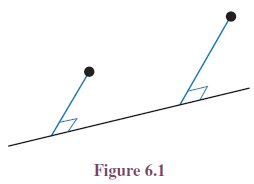Mathematics - Two Dimensional Analytical Geometry: Introduction | 11th Mathematics : UNIT 6 : Two Dimensional Analytical Geometry
Chapter: 11th Mathematics : UNIT 6 : Two Dimensional Analytical Geometry
Two Dimensional Analytical Geometry: Introduction
Introduction
Francois viete (1540-1603)
introduced the first systematic algebraic
notation and contributed to the theory of equations.Two French
mathematicians-philosophers Rene´ Descartes and Pierre de Fermat independently founded analytical
geometry in the-1630s by adapting Francois viete’s algebra to the study of
geometric loci. Descartes established analytical geometry as“a way of
visualizing algebraic formulas” and developed the coordinate system as “a
device to locate points on a plane”. His main achievement was to bridge the gap
between algebra and geometry. With regard to algebra, he explained in detail
that how algebraic equations can be expressed and explained through the use of
geometrical shapes. Analytical geometry is a great invention of Descartes and
Fermat. Cartesian geometry, the alternative term used for analytical geometry
is named after him.

From the17th century onwards,
mathematics is being developed in two directions: pure and applied mathematics.
One of the first areas of applied mathematic studied in the 17th century was
the motion of an object in a straight line. The straight line graphs can be
used in the fields of study as diverse as business, economics, social sciences,
physics, and medicine. The problem of the shortest line plays a chief and
historically important role in the foundations of geometry.
Given a real-world problem, our
first task is to formulate the problem using the language of mathematics. Many
techniques are used in the construction of mathematical models. Let us see how
linear equations (models) can be constructed from a given set of information
and solved using appropriate mathematical techniques. Consider some of the
real-world, simple problems as illustrated below:
Real life situation
6.1: When a student walks from his house, at an average
speed of 6 kmph, reaches his school by ten minutes before
school starts. When his average speed is 4 kmph, he reaches his school five
minutes late. If he starts to walk to school every day at 8.00 A.M, then how to
find (i) the distance between house and the school (ii) the minimum average
speed to reach the school on time and time taken to reach the school (iii) the
time at which the school starts (iv) the pair of straight lines of his path of walk
(Combined equation of two straight lines).
Real life
situation 6.2: Suppose the Government has
decided to erect a new Electrical Power Trans-mission Substation to provide
better power supply to two villages namely A and B. The substation has to be on the
line l. The distances of villages A and B from the foot of the
perpendiculars P and Q on the line l are 3 km and 5 km respectively
and the distance between P and Q is 6 km. How to calculate the smallest length of cable required to connect the
two villages (or the roads that connect
the villages as well as the power station) from the power station and to
find the equations of the cable lines (or roads) that connect the power station
to two villages.

Real life
situation 6.3:
Consider a hollow cylindrical
vessel, with circumference 24 cm and height 10 cm. An ant is located on the
outside of vessel 4 cm from the bottom. There is a drop of honey at the
diagrammatically opposite inside of the vessel, 3 cm from the top. What is the
shortest distance the ant would need to crawl to get the honey? What is the
equation of the path traced out by the ant. Here is a picture that illustrates
the position of the ant and the honey.

Real life
situation 6.4: The quantity demanded of a certain type of Compact Disk is
22,000 units when a unit price is Rs. ![]() 8. The
customer will not buy the disk, at a unit price of Rs.
8. The
customer will not buy the disk, at a unit price of Rs. ![]() 30 or
higher. On the other side the manufacturer will not market any disk if the
price is Rs.
30 or
higher. On the other side the manufacturer will not market any disk if the
price is Rs. ![]() 6 or lower. However, if the price is Rs.
6 or lower. However, if the price is Rs. ![]() 14 the
manufacturer can supply 24,000 units. Assume that the quantity demanded and
quantity supplied are linearly proportional to the price. How to find (i) the
demand equation (ii) supply equation (iii) the market equilibrium quantity and
price. (iv) The quantity of demand and supply when the price is Rs.
14 the
manufacturer can supply 24,000 units. Assume that the quantity demanded and
quantity supplied are linearly proportional to the price. How to find (i) the
demand equation (ii) supply equation (iii) the market equilibrium quantity and
price. (iv) The quantity of demand and supply when the price is Rs. ![]() 10.
10.
The equation of the straight line for each of the problems stated above, not only solves the specific case of solutions but also helps us get many information through it. Later, in this chapter, let us try to solve these types of problems by using the concepts of straight lines. In order to understand the straight line, we need to get acquainted with some of its basic concepts.
Related Topics